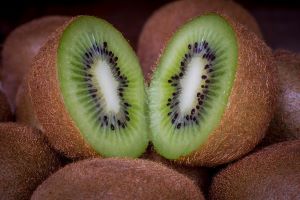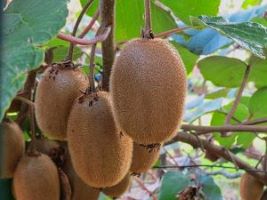What is Kiwifruit?
 Kiwifruit,
is a small, oval-shaped fruit with a fuzzy brown skin and vibrant green flesh on the inside.
It has tiny black seeds scattered throughout and is known for its sweet and tangy flavor.
Kiwifruit belongs to the genus Actinidia, and the most commonly eaten variety is the Actinidia deliciosa.
Kiwifruit is rich in vitamin C, antioxidants, and dietary fiber, making it a healthy addition to a balanced diet.
It's often eaten raw, either by cutting it in half or peeling off the skin.
Some people enjoy it in smoothies, fruit salads, or as a topping for yogurt and desserts.
Kiwifruit,
is a small, oval-shaped fruit with a fuzzy brown skin and vibrant green flesh on the inside.
It has tiny black seeds scattered throughout and is known for its sweet and tangy flavor.
Kiwifruit belongs to the genus Actinidia, and the most commonly eaten variety is the Actinidia deliciosa.
Kiwifruit is rich in vitamin C, antioxidants, and dietary fiber, making it a healthy addition to a balanced diet.
It's often eaten raw, either by cutting it in half or peeling off the skin.
Some people enjoy it in smoothies, fruit salads, or as a topping for yogurt and desserts.
How kiwifruit is grown
Kiwifruit is grown on deciduous vines, and cultivating it requires specific conditions to ensure the fruit develops properly. Here's an overview of how kiwifruit is grown:
-
Climate
Kiwifruit thrives in mild climates, typically in areas with warm summers and cool winters. It requires at least 200-300 frost-free days each year to produce high-quality fruit. The best growing zones are usually found in regions with a Mediterranean climate, such as parts of New Zealand, Italy, and California. -
Soil
The soil should be well-draining, fertile, and rich in organic matter. Kiwifruit vines do not tolerate waterlogged soils, so good drainage is essential to prevent root rot. Soil pH should ideally be slightly acidic (around 5.5 to 6.5). -
Planting
Kiwifruit vines are typically propagated through cuttings or grafting. It's common to plant a mix of male and female vines, as kiwis require cross-pollination to bear fruit. For every 5 to 8 female plants, one male plant is needed for pollination. Vines are often spaced 10 to 12 feet apart to allow them to spread and grow. -
Vine Care
Kiwifruit vines are vigorous growers and need support structures like trellises or arbors to keep the vines off the ground. This makes it easier to harvest and ensures better airflow around the plants. Pruning is essential to control the vine’s growth and to encourage the production of fruit-bearing shoots. It also helps with airflow and reduces the risk of diseases. -
Pollination
Kiwifruit flowers are typically small and white or cream-colored. Only female plants produce fruit, and they require pollen from male plants for fertilization. Pollination usually occurs through insects, particularly bees. Some orchards may also use hand-pollination in areas where natural pollinators are scarce. -
Growing Season
Kiwifruit vines produce flowers in the spring, and the fruit begins to form shortly afterward. It typically takes 7 to 9 months for the fruit to mature, depending on the variety and local climate. The fruit is harvested in the fall when it reaches the desired size and flavor, though it is usually harvested while still firm to allow it to ripen off the vine. -
Harvesting and Post-Harvest
After harvesting, kiwifruit is stored in controlled conditions to allow it to ripen. During this time, the fruit softens and becomes sweeter. The fruit's skin is typically not eaten, but it is edible if desired. Most people peel the skin before consuming the green flesh. Growing kiwifruit requires a lot of patience and care, as the vines can take a few years to start producing fruit after planting. However, once established, they can yield fruit for many years.

